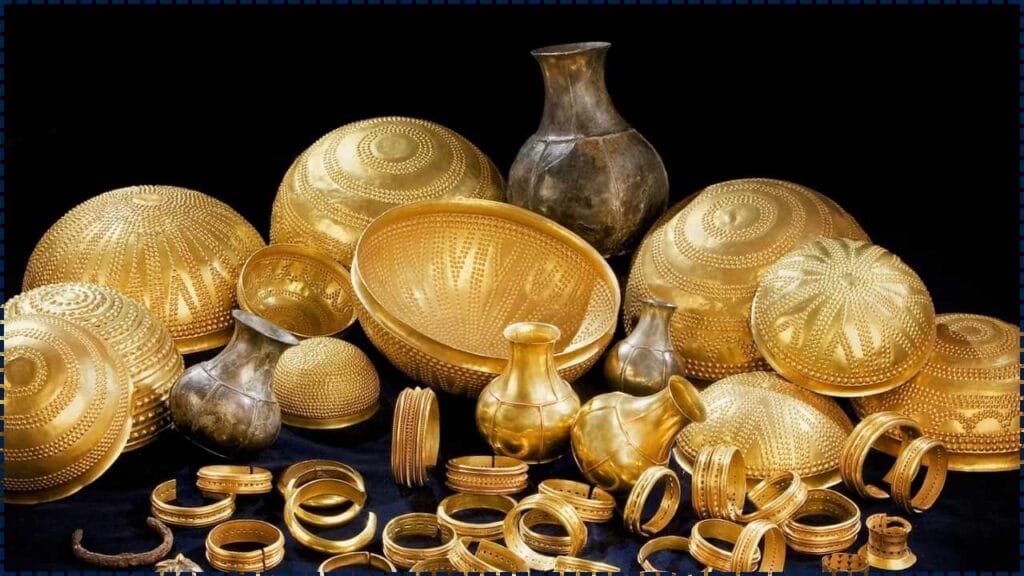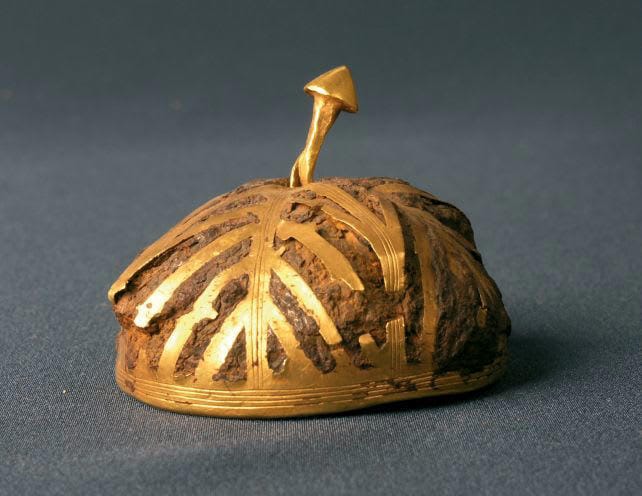3,000‑Year‑Old Treasure Trove Reveals Mysterious Metal Believed to Be From an Alien World—sounds like sci-fi, but it’s the real deal. Deep in Spain’s famed Treasure of Villena, archaeologists just confirmed that two Bronze Age items—a bracelet and a decorative hemisphere—were crafted from meteoritic iron, a metal literally fallen from space centuries before Earth-based iron smelting began.

3,000-Year-Old Treasure Trove Reveals Mysterious Metal
| Aspect | Details |
|---|---|
| Site | Treasure of Villena, Alicante, Spain; discovered 1963 (heritagedaily.com) |
| Artifacts | C-shaped bracelet & gold-covered hemisphere from c. 1400–1200 BCE |
| Metal Type | Confirmed meteoritic iron (nickel-rich alloy) |
| Significance | Oldest meteoritic-iron objects in Iberia; predate local smelting (~850 BCE) |
| Technology | Indicates early mastery of cold- or hot-working tough iron alloys |
| Symbolic Power | Likely revered as celestial or elite items |
| Archaeological Impact | Encourages reanalysis of older iron finds, triggers global cosmic metal search |
3,000-year-old artifacts reveal that early humans were far more than resource users—they cherished celestial metals, crafted with technical brilliance, and created cosmic symbols of status and wonder. Found in 2025, these treasures from the pre-Iron Age rewrite history, showing a deep connection to the stars. They invite us to blend archaeology with astro-material science, inspiring communities, scholars, and dreamers to look up and care for our shared past. Here’s a simple, heartfelt guide to their meaning.
Unearthed in Spain’s Villena Treasure, these artifacts—like gold bracelets and bottles—contain meteoritic iron, a rare metal from fallen stars. Dating to 1400-1200 BCE, they show Bronze Age people valued sky metals as sacred.

What’s the Treasure of Villena All About?
Unearthed in 1963 near Alicante, Spain, the Treasure of Villena ranks as one of Europe’s richest Bronze Age hoards, with 66 items of gold, silver, amber, and now—space rock. The unexpected pieces? A corroded iron bracelet and a gold-inlaid hemisphere, used as weapon decoration. Their cosmic origin transforms them from curiosities into chapters of ancient technological innovation.
How Did Scientists Know It Was from Space?
Nickel-Rich Clues
Mass spectrometry pinpointed nickel levels exceeding 5%, matching meteoritic iron’s known profile—terrestrial iron from Bronze Age smelting can’t compete.
Timeline Puzzle Solved
These items date back to 1400–1200 BCE, centuries before Iberian smelting (~850 BCE), confirming their cosmic provenance. (timesofindia.indiatimes.com)
First of Its Kind in Iberia
This is the earliest confirmed meteoritic-iron use in the region—joining only rare global instances like Tutankhamun’s dagger and Egyptian beads.
Why This Discovery Is Monumental
Technical Talent
Working meteoritic iron—tough, nickel-rich, and brittle—was no easy feat. smiths displayed refined techniques, hinting at early metallurgical innovation.
Cosmic Status
Meteoric metal had mystical allure. Worn or wielded by elites, it symbolized power, perhaps divine or ancestral, echoing myths and astrology.
Global Footprint
This find urges archaeologists worldwide to reanalyze old iron artifacts—many may hide meteorite origins. Lab methods using Fe–Co–Ni ratios now identify star metals non-invasively. (researchgate.net)
Related Links
Dangerous Levels of Uranium Found in Colorado Reservoir – Officials Warn Residents to Stay Alert
Guide for Researchers & Scholars
1. Reassess Bronze‑Age Iron
Use portable XRF to scan museum collections. Detecting Ni/Fe/Co ratios can reveal cosmic iron.
2. Map Meteorite Falls & Routes
Overlay cosmic debris maps with artifact find spots—trace early trade networks featuring star-metal.
3. Conduct Cultural Comparisons
Compare cosmic-temped artifacts globally—from Egyptian beads to Chinese axes—to understand social status dynamics.
4. Build Ethical Conservation
Meteoritic iron corrodes uniquely. Tailor preservation plans to defend both structure and symbolism.
5. Engage Public in Cosmic Heritage
Use this discovery to teach kids and adults about prehistoric science, material culture, and space connectivity.
FAQs
Q1: Why is meteoritic iron nicknamed “iron from the sky”?
Because it’s literal debris from meteorites—iron-nickel metal forged in space, not smelted on Earth.
Q2: How do we know it’s meteoritic?
Analysis shows high nickel (≥5%) and Fe–Co–Ni ratios matching space metals, not Earth ores.
Q3: Were such artifacts common?
Rare. They show up in ancient Egypt (Tut’s dagger), Syria, and Switzerland—but Villena’s find is Spain’s first and a Bronze Age earliest. (smithsonianmag.com)
Q4: Did every high-status person wear cosmic metal?
Nope—only certain elites could access and shape it. Its rarity made it a true status symbol.
Q5: What does this mean for archaeology?
It starts a new wave: re-check old finds, seek cosmic traces, and blend archaeology with astrophysical context.








